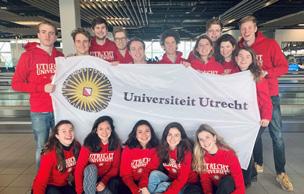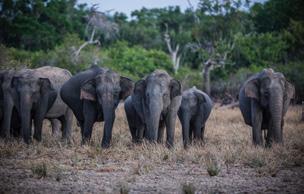
8 minute read
Butterflies tell the story of biodiversity
‘Funding the Future’ is the name of the annual fundraising campaign organised by the Utrecht University Fund. Each year, friends, alumni, staff and students give generously to the projects selected by the Fund.
Advertisement
In 2019, you raised the wonderful amount of 135,301 euros which was divided over four promising projects. In addition to the permanent butterfly house, the Utrecht University Fund also provided support to talented students through the university’s grant programme, the Incluusion programme for refugee students and the BioCliVE experiment, in which UU biologists are working to determine how grassland biodiversity affects global food supplies and exploring its impact on carbon storage in our future climate. The Utrecht University Fund will also be raising funds for four wonderful Funding the Future projects in 2020.
Orange-white, black-purple or translucent as a sheet of glass: dozens of butterfly species have been fluttering through the Botanical Garden’s new butterfly house since May of 2019. Prior to the construction of the current permanent garden, an existing greenhouse was converted into a butterfly paradise before the start of every summer.
As Wim Kersten – biologist and resident butterfly expert at the Botanical Gardens – explains, it was a lot of work to convert the greenhouse every year. ‘Building up and tearing down the butterfly garden took us eight weeks in all.’ However, the temporary butterfly garden had another more serious drawback. It didn’t offer the necessary capacity to raise permanent butterfly populations. Wim: ‘We couldn’t raise all the various species in a sustainable way. That’s unfortunate, especially in terms of education. You can’t show visitors the entire life-cycle from egg to butterfly.’ A temporary butterfly garden just wasn’t an option anymore, in other words. The Botanical Gardens finally decided to raise money for an actual butterfly paradise in 2018. They did so with the support of the Utrecht University Fund, which incorporated the project in the annual Funding the Future campaign. The result? 185 donors raised a total of 7,726.96 euros. The K.F. Hein Fund, an equity fund allied with the Utrecht University Fund, also donated 6,000 euros to the project. These contributions, together with other generous donations, helped make the butterfly house a reality in no time.
OUR VERY OWN BUTTERFLY POPULATION
The butterfly garden has been one of the Botanical Garden’s most popular attractions since its official opening. In fact, half the Garden’s visitors travel to Utrecht to see the butterflies. The butterfly house also attracts regular visits from schools and has become a hotspot for butterfly photographers. Wim and the other volunteers also love the new butterfly garden. ‘I’m really grateful. We’re getting weekly shipments of between 50 to 100 pupae from the Philippines, Kenya and Costa Rica, which means we can now raise our own populations.’ Mail-order butterflies? ‘Definitely! We get our butterflies from butterfly farms. They’re usually located in villages near the forests where the butterflies live. The locals occasionally catch female butterflies, which can easily lay up to 200 eggs. They wait till the eggs have grown into caterpillars and pupated, and ship them over here. In addition to helping us and all other butterfly gardens in the Netherlands, this trade also offers an economic incentive to conserve the local forests. And, perhaps even more importantly: butterflies, with their wealth of colours and patterns, tell the story of biodiversity and its crucial value. Every part of our ecosystem plays its own key role. That also goes for butterflies. Butterflies pollinate flowers and plants, and the females’ eggs and caterpillars that hatch from them are an important source of food for other species.’ Unfortunately, biodiversity is declining at a startling rate in both the Netherlands and wider world. Wim: ‘That’s bad news: like us, butterflies are also dependent on biodiversity. Butterfly caterpillars are picky eaters and usually only eat one or a handful of plant species: their host plant. Butterflies specifically seek out these plants in order to lay their eggs. If these plants go extinct, the butterfly species that depends on them is likely to follow. That’s why it’s so important to get our visitors – and, more importantly, children – interested in biodiversity and encourage them to help build a more diverse environment. For example, I offer tips on making their own garden more butterfly-friendly.’
LIVING PROJECT
There are twelve butterfly gardens in the Netherlands. So what makes the Botanical Gardens butterfly garden so unique? Wim: ‘The personal interaction. The butterfly gardens in major zoos are really large. Visitors tend to walk through them and think: well, that was nice. We regularly have volunteers that can explain and show you all sorts of interesting things. Our butterflies are also very active. The pupae hatch right in front of our visitors’ eyes, and the butterflies flutter from plant to plant. It’s a perfect opportunity to see them from up close and take some great pictures.’ Although the butterfly house is now finished and the net has been installed, there’s still more work to do, Wim explains. ‘The butterfly house is a living project. The caterpillars eat the leaves, so we’re constantly putting in new plants and farming new butterflies.’ So what’s Wim’s biggest wish? ‘I’d love to import a rare species like the birdwing butterfly and grow our own population here in Utrecht.’
The impact of named funds
Named funds are designed to let the founder determine what their donations will be spent on. The Utrecht University Fund managed a total of 29 named funds in 2019. These funds contribute to a broad range of academic goals, from encouraging the broad academic development of our students to facilitating fundamental research in the field of geochemistry, and from realising educational projects in the Botanical Gardens to supporting patient-oriented research in the field of internal medicine.
Named funds are built on major donations from their founders. Some named funds actively raise funds from other donors, while others do not. Despite these differences, all named funds have one thing in common: they make a difference by providing much-needed financial support.
So what did donations from our named funds go to in 2019? We have highlighted some inspiring examples below.
The Utrecht University Model United Nations delegation on its way to Harvard University.

Biofabrication enables us to repair or replace damaged organs.


UU researchers are working to develop a vaccine and treatment for a lethal virus affecting Asian elephants.

The Centre for Complex Systems Studies tackles social issues such as climate change on the basis of models and theories from the Natural Sciences.
‘I had opportunities to study abroad, which really helped boost my career. I want to make sure the current generation gets to enjoy those same experiences and benefits. It’s also important that students can orient themselves broadly rather than merely gaining in-depth knowledge of their chosen field.’
Yvonne van Rooy, LLM, founder of the Yvoor Fund
MINDERHOUD FUND AND USC SCHOLARSHIP FUND
UVSV/VVSNU and USC alumni often request that their donations to the Utrecht University Fund are designated to the Minderhoud Fund or USC Scholarship Fund. These named funds award grants to society members seeking to undertake a prestigious work placement or study project. For example, the Minderhoud Fund helped students Manouk Alderliesten and Frederiek van Welderen Rengers take part in this year’s Model United Nations conference at Harvard University. Participants train diligently for this prestigious competition, in which students simulate UN conferences and apply their well-honed collaboration, negotiation and speeching skills.
HOFVIJVERKRING FELLOWSHIP
One of the six Hofvijverkring Fellowship scholarships made available to talented young researchers in 2019 went to Dr Riccardo Levato. Levato is researching 3D bioprinting at University Medical Centre Utrecht and studying stem cell printing technologies. He hopes to develop specific parts of the knee joint in the laboratory in order to treat wounds or degeneration. The grant enabled him to visit a Japanese research group that has developed a unique nano technology application in this field. The specific knowledge and insights gained during his visit will be of great use during Riccardo’s further research.
FRIENDS OF VETERINARY MEDICINE
The Asian elephant is currently in danger of becoming extinct. Elephant Endotheliotropic Herpes Virus (EEHV), which causes a highly complex disease, is the leading cause of death among young elephants. ‘Unfortunately, we still don’t have an effective treatment or vaccine at the moment. We need more research to develop a rapid diagnosis method and effective vaccine,’ explains Prof. Victor Rutten. Friends of Veterinary Medicine helped raise funds for his research project with Dr Tabitha Hoornweg and Dr Xander de Haan in 2019. The fundraising campaign generated a great deal of media attention in outlets such as de Telegraaf and Algemeen Dagblad newspapers, Jeugdjournaal children’s news programme and RTV Utrecht and RTL Nieuws.
SWAANTJE MONDT FUND
The Swaantje Mondt Fund supports PhD candidates specialising in Law and Complex Systems. In 2019, the fund facilitated a fellowship for Italian PhD candidate Marta Magnani. Magnani is studying ecosystems under extreme conditions. She is working to predict the resilience of ecosystems and their reactions to climate change using simplified empirical models based on large data sets. As a part of her research at the UU Centre of Complex Systems Studies, she has developed a new dynamic model based around various ecological factors. The model should help us gain greater insight into the causes of natural fires in Southern Europe.
The Utrecht University Fund managed a total of 29 named funds in 2019, which are listed below. Visit uu.nl/namedfunds for links to the various funds’ web pages and their specific objectives. You can also make donations via this page.
Named funds that actively solicit donations. (donors may also contribute):
A.F. Monna Fund BINF Fund Hofvijverkring Veterinary Medicine Anniversary Fund Minderhoud Fund Olaf Schuiling Fund Professor A.R. de Bruijn Fund RechtOpLeren Fund Ronald van Kempen Fund Rosanna Fund UCU Scholarship Fund USC Scholarship Fund Friends of the Botanical Gardens Friends of Veterinary Medicine Friends of Humanities Yvoor Fund
Named funds that do not engage in active fundraising:
Aurelius Fund Christiane Seidel Fund Complex Systems Fund Cor en Tine Drooger Fund Familie van Leerzem Fund International Economic Law Fund Godard Van Reede Fund Maria Naundorf van Gorkum Fund Martijn Zwart Fund Scrinerius Fund Swaantje Mondt Fund Trappeniers-Wols Fund Truida Schok Fund







